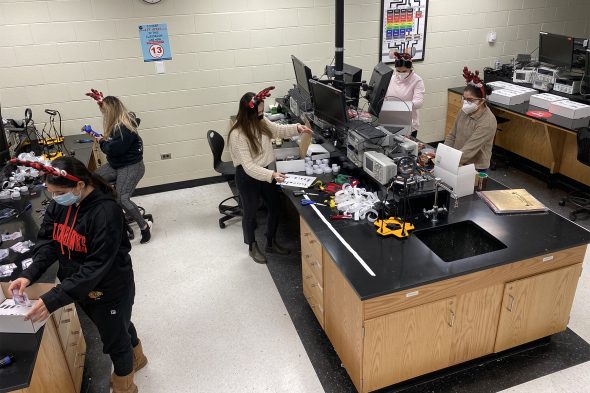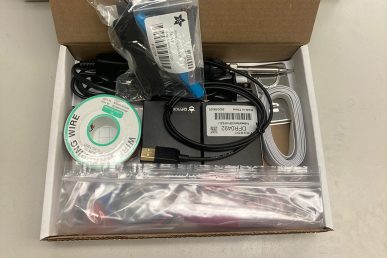Wearable technology course expands to meet demand

As the COVID -19 pandemic continues, the need to be constantly aware of one’s own medical and fitness data has meant a rise in the demand for fitness trackers and wearable technology.
This same need to have an accurate and constant assessment of one’s own numbers has led to increased demand for the Wearables and Nearables Technology Laboratory course at the University of Illinois Chicago. The course in the College of Engineering was designed to plug into the quickly growing wearable technology trend that has saturated the market with portable fitness trackers, smart homes and other devices.

Clinical associate professor Hananeh Esmailbeigi, who created the class several years ago, said the continued demand for the class has meant that it also was offered during the spring semester after being offered in the fall. Previously, the class was only offered once during the school year. In addition, the number of students allowed in the class has nearly doubled from 32 to 60 students.
“I think students are really interested in hands-on, engaging content,” Esmailbeigi said.
Esmailbeigi, who also is associate director of undergraduate studies in the bioengineering department, joined Joe Hummel, clinical associate professor and director of undergraduate studies in computer science, both within the College of Engineering, to cross-reference the class.
Even as Esmailbeigi was teaching the course in the fall semester, she began to look ahead to this spring semester to bring it back right away. To help teach the class, she hired four undergraduate students to assist her.
“We had a feeling that this class was becoming popular among the students and that they were enjoying it,” she said. “Because it was so successful among students, we are offering it again this semester.”
The goal for the class is for students to work in multidisciplinary teams to mimic a “real industry environment” that requires people to work with others from different disciplines, Esmailbeigi said.
The wearable technology they have developed includes devices that track your gait when walking, a fitness band that checks breathing and heart rates, and sensors that track blood oxygenation levels. They’ve also had a “smart tattoos” lab, where students design tattoos that can be worn on the skin and used to do everything from help play musical instruments or type, among other things, she said.
The 400-level course previously had been capped at 32 students, who tended to be seniors and graduate students. Normally, eight groups of four students are made up of a combination of bioengineering, mechanical engineering and computer science students who team up and collaborate in a campus lab to produce a single wearable technology device.

But in the fall, after classes went online, students were responsible for their own device, from start to finish. The same is required for the spring semester. To prepare for the spring class, Esmailbeigi and her teaching assistants spent the winter break preparing kits with enough components to build the devices.
Esmailbeigi and the teaching assistants put together enough materials to make 60 kits containing enough wiring, circuit boards and other components to make the devices, as well as surplus parts. They then mailed them to the students.
The groups will be meeting together on Blackboard, where they will be tasked with helping each other out.
Adwait Chavan, a senior majoring in computer science, said that what attracted him to the course was the ability and knowledge it gave him to design and create wearable devices.
“In current times like ours, it has become extremely important for technology to facilitate and simplify day-to-day human activities, and this course was instrumental in providing me with the tools to progress on this path,” Chavan said.
While classes around the country went virtual, including most of UIC’s, Chavan said it worked out to the advantage of students in the class because each student was responsible for their own device. At the same time, they were able to work as teams with each other virtually. This helped to serve to bond the students together, even if it was virtually.
“Creating our own individual devices challenged each one of us to focus on our own device while also working together with the team for any issues, errors, or bugs faced,” Chavan said. “The team plays a very important role in motivating an individual in the right direction, and for planning, designing and working on the entire building and presentation of the wearable device.”
Rudy Calderon, a senior majoring in bioengineering, also liked the online aspect because it allowed him to have an opportunity to work on the project as a whole. At the same time, he said he really liked the collaborative aspect of the course.
“It was very refreshing to work with peers who had very different skills and technical backgrounds,” Calderon said.
“The online version of this class allowed my teammates and I to each individually construct a version of our device to build our rapid prototyping skills while all collaborating on the code to further our programming skills. This field is something that I have always been interested in, and now I am excited to learn more about this field throughout my remaining time at UIC and beyond.”
Warisa Siewsrichol, a senior majoring in computer science who also was in the class in the fall semester, said she really liked how the class was structured virtually and how they were supplied with kits that allowed them to make the devices on their own schedules.
“I had more time to work on the project outside of class time,” Siewsrichol said. “Being online, we had a kit that I was able to work on slowly and not rush with time when building the part.”
Siewsrichol said the team aspect helped students learn from each other, especially as many were from different majors who could bring in their own knowledge to share with each other.
“Everyone had a part to play; I enjoyed learning the new technology that is currently being created and is already out into practice,” Siewsrichol said. “It is mind-blowing to see how far technology has gone and I did not even know. Also, there was always room for creativity in each project, which I really enjoyed as well.”
